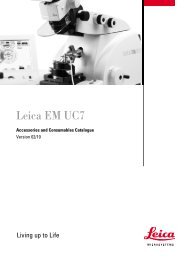Physical Principles of Electron Microscopy: An Introduction to TEM ...
Physical Principles of Electron Microscopy: An Introduction to TEM ...
Physical Principles of Electron Microscopy: An Introduction to TEM ...
Create successful ePaper yourself
Turn your PDF publications into a flip-book with our unique Google optimized e-Paper software.
112 Chapter 4<br />
Unfortunately, the value <strong>of</strong> L is sensitive <strong>to</strong> small differences in specimen<br />
height (relative <strong>to</strong> the objective-lens polepieces) and <strong>to</strong> magnetic hysteresis<br />
<strong>of</strong> the <strong>TEM</strong> lenses, such that a given lens current does not correspond <strong>to</strong> a<br />
unique magnetic field or focusing power. <strong>Electron</strong> diffraction is therefore <strong>of</strong><br />
limited accuracy: d-spacings can be measured <strong>to</strong> about 1%, compared with a<br />
few parts per million in the case <strong>of</strong> x-ray diffraction (where no lenses are<br />
used). However, x-ray diffraction requires a macroscopic specimen, with a<br />
volume approaching 1 mm 3 . In contrast, electron-diffraction data can be<br />
obtained from microscopic volumes (< 1 �m 3 ) by use <strong>of</strong> a thin specimen and<br />
an area-selecting aperture or by focusing the incident beam in<strong>to</strong> a very small<br />
probe. <strong>Electron</strong> diffraction has been used <strong>to</strong> identify sub-micrometer<br />
precipitates in metal alloys, for example.<br />
Some materials such as silicon can be fabricated as single-crystal<br />
material, without grain boundaries. Others have a crystallite size that is<br />
sufficiently large that a focused electron beam passes through only a single<br />
grain. In these cases, there is no azimuthal randomization <strong>of</strong> the diffraction<br />
spots: the diffraction pattern is a spot pattern, as illustrated in Fig. 4-12d.<br />
Equation (4.22) still applies <strong>to</strong> each spot, R being its distance from the<br />
central (0 0 0) spot. In this case, the symmetry <strong>of</strong> the diffraction spots is<br />
related <strong>to</strong> the symmetry <strong>of</strong> arrangement <strong>of</strong> a<strong>to</strong>ms in the crystal. For example,<br />
a cubic crystal produces a square array <strong>of</strong> diffracted spots, provided the<br />
incident beam travels down one <strong>of</strong> the crystal axes (parallel <strong>to</strong> the edges <strong>of</strong><br />
the unit cell). Using a double-tilt specimen holder, a specimen can <strong>of</strong>ten be<br />
oriented <strong>to</strong> give a recognizable diffraction pattern, which helps <strong>to</strong>ward<br />
identifying the phase and/or chemical composition <strong>of</strong> small crystalline<br />
regions within it.<br />
4.8 Diffraction Contrast within a Single Crystal<br />
Close examination <strong>of</strong> the <strong>TEM</strong> image <strong>of</strong> a polycrystalline specimen shows<br />
there can be a variation <strong>of</strong> electron intensity within each crystallite. This<br />
diffraction contrast arises either from a<strong>to</strong>mic-scale defects within the crystal<br />
or from the crystalline nature <strong>of</strong> the material itself, combined with the wave<br />
nature<br />
<strong>of</strong> the transmitted electrons, as we will now discuss.<br />
Defects in a crystal, where the a<strong>to</strong>ms are displaced from their regular<br />
lattice-site positions, can take several different forms. A dislocation is an<br />
example <strong>of</strong> a line defect. It represents either the termination <strong>of</strong> an a<strong>to</strong>mic<br />
plane within the crystal (edge dislocation) or the axis <strong>of</strong> a “spiral staircase”<br />
where the a<strong>to</strong>mic planes are displaced parallel <strong>to</strong> the dislocation line (screw<br />
dislocation). The structure <strong>of</strong> an edge dislocation is depicted in Fig. 4-14,<br />
which shows how planes <strong>of</strong> a<strong>to</strong>ms bend in the vicinity <strong>of</strong> the dislocation



